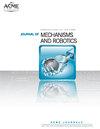Motion Performance Study of 2UPR-1RPS/2R Hybrid Robot based on Kinematics, Dynamics and Stiffness Modeling
IF 3.2
4区 计算机科学
Q2 ENGINEERING, MECHANICAL
Journal of Mechanisms and Robotics-Transactions of the Asme
Pub Date : 2023-08-10
DOI:10.1115/1.4063169
引用次数: 0
Abstract
The unique structural characteristics of hybrid robots, such as few-DOF and redundant constraints, lead to a series of challenges in the establishment of theoretical models. However, these theoretical models are indispensable parts of motion control. Therefore, this paper focus on establishing the kinematics, dynamics and stiffness models for an Exechon-like hybrid robot, which are then used for error compensation and velocity planning to improve the robot motion performance. Firstly, the kinematic model is derived through intermediate parameters and the kinematics equivalent chains. By analyzing the parasitic motion due to few-DOF, the redundant equations in the model are eliminated to obtain the solution of inverse kinematics. Secondly, based on the beam element, the optimal equivalent configuration of the moving platform which connects the parallel part and serial part is determined and then an entire equivalent structure of the robot is formed. It helps establish the stiffness model by using the Matrix Structure Analysis method. Next, the dynamic model is established by combining the Newton Euler method with co-deformation theory to solve the underdetermined dynamic equations caused by redundant constraints. Finally, the compensation method is designed based on the stiffness model and kinematic model to improve the end positioning accuracy of the robot; the velocity planning algorithm is designed based on the dynamic model and kinematic model to enhance the smoothness of the robot motion. The methods proposed in this paper are also of referential significance to other Exechon-like hybrid robots.基于运动学、动力学和刚度建模的2UPR-1RPS/2R混合机器人运动性能研究
混合动力机器人独特的结构特点,如少自由度和冗余约束等,给理论模型的建立带来了一系列挑战。然而,这些理论模型是运动控制不可缺少的一部分。因此,本文重点建立了类execon混合机器人的运动学、动力学和刚度模型,并将其用于误差补偿和速度规划,以提高机器人的运动性能。首先,通过中间参数和运动学等效链推导出运动学模型;通过对少自由度的寄生运动进行分析,消除了模型中的冗余方程,得到了运动学逆解。其次,基于梁单元,确定连接并联部分和串联部分的运动平台的最优等效构型,形成机器人的整体等效结构;利用矩阵结构分析法建立了结构刚度模型。其次,将牛顿-欧拉法与共变形理论相结合,建立动力学模型,求解冗余约束引起的欠定动力学方程。最后,设计了基于刚度模型和运动学模型的补偿方法,提高了机器人的末端定位精度;在动力学模型和运动学模型的基础上,设计了速度规划算法,提高了机器人运动的平稳性。本文提出的方法对其他类execon混合机器人也具有参考意义。
本文章由计算机程序翻译,如有差异,请以英文原文为准。
求助全文
约1分钟内获得全文
求助全文
来源期刊

Journal of Mechanisms and Robotics-Transactions of the Asme
ENGINEERING, MECHANICAL-ROBOTICS
CiteScore
5.60
自引率
15.40%
发文量
131
审稿时长
4.5 months
期刊介绍:
Fundamental theory, algorithms, design, manufacture, and experimental validation for mechanisms and robots; Theoretical and applied kinematics; Mechanism synthesis and design; Analysis and design of robot manipulators, hands and legs, soft robotics, compliant mechanisms, origami and folded robots, printed robots, and haptic devices; Novel fabrication; Actuation and control techniques for mechanisms and robotics; Bio-inspired approaches to mechanism and robot design; Mechanics and design of micro- and nano-scale devices.
 求助内容:
求助内容: 应助结果提醒方式:
应助结果提醒方式:


